On this page
Books about AsitiesThis page lists books that are totally or partially about Asities. The books are listed in order of publication date with the most recent at the top.
Asities
Family: Philepittidae
The Asities are a family of 4 species endemic to Madagascar.
Velvet Asity
Philepitta castanea
Schlegel's Asity
Philepitta schlegeli
Common Sunbird-asity
Neodrepanis coruscans
Yellow-bellied Sunbird-asity
Neodrepanis hypoxantha
|
|
|
|
The Birds of Africa, Volume VIII: The Malagasy RegionEditors: Roger Safford, Frank Hawkins
Illustrations: John Gale, Brian Small
Christopher Helm
2013
"The Birds of Africa series, volumes I–VII, covered the avifauna of continental Africa. This volume fulfils the aspiration, expressed in that series, of a single volume that treats the birds of Madagascar, Seychelles, the Comoros, the Mascarenes and their associated smaller outlying islands – the Malagasy region. It follows The Birds of Africa series in treating each of the 352 regularly occurring species known from the region in detail, through the assembly of a wealth of information, much of it very recent. Distribution, description, identification, general behaviour, feeding and breeding habits are comprehensively covered, by a roster of the key experts on the birds of the region. All 135 vagrant species are also treated, more briefly, and for the first time the distribution of species across the region is presented in a series of detailed and informative maps. Each species is also extensively illustrated, showing variation in plumage across ages, sexes and geographic regions. One plate illustrates species that have recently become extinct in the region, and a separate plate section covers vagrants."
|
Buy from amazon.co.uk 
|
|
Handbook of the Birds of the World, Vol. 8: Broadbills to TapaculosEdited by Josep Del Hoyo, Andrew Elliott and David Christie
Lynx Edicions
2003
845 pages, 81 colour plates, 470 colour photos, 672 distribution maps.
This volume covers broadbills, asities, pitas, ovenbirds, woodcreepers, typical antbirds, ground-antbirds, gnateaters and tapaculos.
|
Buy from amazon.co.uk 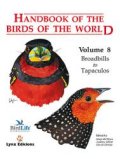
|
|
Pittas, Broadbills and AsitiesFrank Lambert and Martin Woodcock
Pica Press
2000
"This study covers two widely-known groups of Old-World tropical birds. Pittas are a gound-dwelling insectivorous species. Broadbills form a more diverse group - some being highly specialized insectivores, others being fructivores. The Asities of Madagascar are also included. In total the guide includes 51 species. There are introductory chapters giving general information about the families. The species accounts include information on identification, habits, breeding, habitats, distribution and status. Includes colour plates of all species and distribution maps."
|
Buy from amazon.co.uk 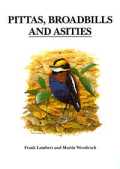
|
|
Catalogue Of The Passeriformes or Perching Birds In The Collection Of The British MuseumOligomyodae, or the Families Tyrannidae, Oxyrhamphidae, Pipridae, Cotingidae, Phytotomidae, Philepittidae, Pittidae, Xenicidae, and Eurylaemidae
Catalogue Of The Birds In The British Museum, Volume XIV
Philip Lutley Sclater
26 colour plates: J. Smit
Printed By Order Of The Trustees
Printed by Taylor & Francis
1888
From the introduction: "My ornithological studies having been principally devoted to South-American Birds, I had little hesitation in acceding to Dr. Gunther's request that I should prepare the Catalogue of the Mesomyodian Passeres in the Collection of the British Museum. Of the thirteen families that belong to this section of the Passerine group, nine are exclusively Neotropical, and these nine families embrace by far the greatest number of specific forms, the four Mesomyodian families as yet recognized in the Old World being comparatively insignificant in point of numbers. My subject was, therefore, sufficiently familiar to me. At the same time some of the groups to be treated of - I may point especially to the Tyrannidae - are universally allowed to be amongst the most difficult portions of the class of Birds for satisfactory determination. I felt, therefore, that in the short time that could necessarily be allowed me for the completion of my task I had no easy duty to perform."
|
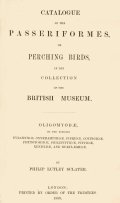
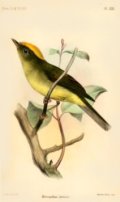
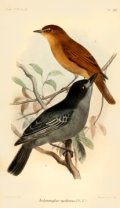 |
|